Related Research Articles

Star Trek II: The Wrath of Khan is a 1982 American science fiction film directed by Nicholas Meyer and based on the television series Star Trek. It is the second film in the Star Trek film series following Star Trek: The Motion Picture (1979), and is a sequel to the television episode "Space Seed" (1967). The plot features Admiral James T. Kirk and the crew of the starship USS Enterprise facing off against the genetically engineered tyrant Khan Noonien Singh. When Khan escapes from a 15-year exile to exact revenge on Kirk, the crew of the Enterprise must stop him from acquiring a powerful terraforming device named Genesis. The film is the beginning of a three-film story arc that continues with the film Star Trek III: The Search for Spock (1984) and concludes with the film Star Trek IV: The Voyage Home (1986).

Mark Allen Mothersbaugh is an American musician and composer. He came to prominence in the late 1970s as co-founder, lead singer and keyboardist of the new wave band Devo, whose "Whip It" was a top 20 single in the US in 1980, peaking at No. 14, and which has since maintained a cult following. Mothersbaugh was one of the primary composers of Devo's music.
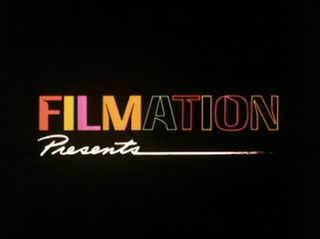
Filmation Associates was an American production company founded by Lou Scheimer, Hal Sutherland and Norm Prescott in 1962, before closing by Group W Productions on February 3, 1989. Located in Reseda, California, Filmation produced animated and live-action productions for cinema and television.

Ghostbusters is a 1984 American supernatural comedy film directed by Ivan Reitman and written by Dan Aykroyd and Harold Ramis. It stars Bill Murray, Aykroyd, and Ramis as Peter Venkman, Ray Stantz, and Egon Spengler, three eccentric parapsychologists who start a ghost-catching business in New York City. It also stars Sigourney Weaver and Rick Moranis, and features Annie Potts, Ernie Hudson, and William Atherton in supporting roles.
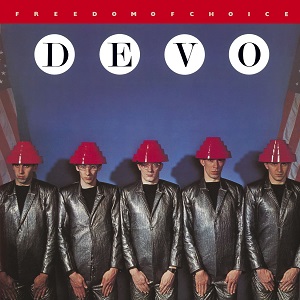
Freedom of Choice is the third studio album by the American new wave band Devo, released in May 1980 on Warner Bros. Records. The album contained their biggest hit, "Whip It", which hit No. 8 and No. 14 on the Billboard Club Play Singles and Pop Singles charts, respectively. Freedom of Choice peaked at No. 22 on the Billboard Pop Albums chart.
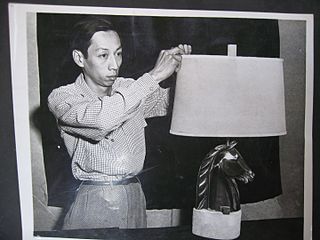
Wah Ming Chang was an American designer, sculptor, and artist. With the encouragement of his adoptive father, James Blanding Sloan, he began exhibiting his prints and watercolors at the age of seven to highly favorable reviews. Chang worked with Sloan on several theatre productions and in the 1940s, they briefly created their own studio to produce films. He is known later in life for his sculpture and the props he designed for Star Trek: The Original Series, including the tricorder and communicator.

Oh, No! It's Devo is the fifth studio album by American new wave band Devo, released in 1982 by Warner Bros. Records. The album was recorded over a period of four months, between May and September 1982, at Cherokee Studios in Hollywood, Los Angeles, and was produced by Roy Thomas Baker.

Gerald Vincent Casale is an American musician. He came to prominence in the late 1970s as co-founder, co-lead vocalist and bass player of the new wave band Devo, which released a top 20 hit in 1980 with the single "Whip It". Casale is the main lyricist and one of the primary composers of Devo's music, as well as the director of most of the band's music videos. He is one of only two members who have been with Devo throughout its entire history. Casale's brother Bob also performed with the band.

Robert Edward Casale Jr., or "Bob 2", was an American musician, composer and record producer. He came to prominence in the late 1970s as the rhythm guitarist and keyboardist of the new wave band Devo, which released a Top 20 hit in 1980 with the single "Whip It". The band has maintained a cult following throughout its existence. He was the younger brother of their co-founder and bass guitarist Gerald Casale.

Duty Now for the Future is the second studio album by American new wave band Devo, released on June 1, 1979, by Warner Bros. Records. Produced by Ken Scott, the album was recorded between September 1978 and early 1979 at Chateau Recorders in Hollywood.

Total Devo is the seventh studio album by American new wave band Devo, released in 1988 by Enigma Records. "Disco Dancer" hit No. 45 on Billboard's Hot Dance Club Play chart for the week of September 3, 1988.

Smooth Noodle Maps is the eighth studio album by the American new wave band Devo. It was originally released in June 1990 and would be their last album released through Enigma. The album was recorded over a period of three months between October 1989 and January 1990, at Master Control Studios, in Burbank, California. Smooth Noodle Maps was Devo's last full-length studio album until the release of Something for Everybody in 2010, as well as the last Devo studio album to feature David Kendrick on drums.
The Ghostbusters franchise consists of American supernatural comedies, based on an original concept created by Dan Aykroyd and Harold Ramis in 1984. The plot follows a group of eccentric New York City parapsychologists who investigate and eliminate ghosts, paranormal manifestations, demigods, and demons. The franchise expanded with licensed action figures, books, comics, video games, television series, theme park attractions, and other branded merchandise.
Robert Margouleff is an American record producer, recording engineer, electronic music pioneer, audio expert, and film producer.
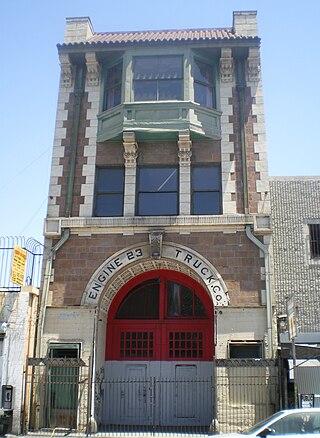
Fire Station No. 23 is a former fire station in Downtown Los Angeles. Built in 1910 as an operating fire station, it was also the Los Angeles Fire Department's headquarters until 1920 and the residence of every fire chief from 1910 to 1928. When it opened, it spawned a political firestorm due to the ornate interior and expensive imported materials, leading to its being called the "Taj Mahal" of firehouses. After 50 years of operation, the station was closed in 1960 as the department began replacing older stations with new facilities. Since the 1980s, Fire Station No. 23 has been a popular filming location. Motion pictures filmed at the station include the Ghostbusters movies, The Mask, Police Academy 2, Flatliners, Firehouse and National Security.
Linda DeScenna is an American set decorator and production designer. She has been nominated for five Academy Awards in the category Best Art Direction.
Michael Minor was an American illustrator and art director on Star Trek: The Original Series, Star Trek: The Motion Picture and Star Trek II: The Wrath of Khan.
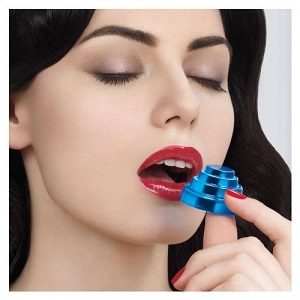
Something for Everybody is the ninth studio album by American new wave band Devo. It was originally released in June 2010 on their original label Warner Bros., and it was their first issued on that label since their sixth studio album Shout in 1984. The album was recorded between July 2007 and mid-2009, at Mutato Muzika, in West Hollywood, California. The album is the last Devo album to feature Bob Casale, who died in February 2014.
John Mark Robinson is an entrepreneur, director, and actor. Films he directed have included Roadhouse 66, Kid, and All Tied Up. He also directed the music videos for various musical artists including Bob Dylan, Tina Turner, Ramones, Pretenders, Bob Seger and Santana. Robinson is the founder and CEO of Tap&Go EV Ltd., owner operator of Vancouver Prop & Costume, and President of Boffi Los Angeles, having previously served as president of Modern Props. Robinson holds Patent No. 10,277,960 for his co-invention of a method and system for seeding video programs with episodic interactive items.
David Kendrick is an American musician who is currently a member of the experimental pop band Xiu Xiu. A former member of Gleaming Spires and Devo, he has recorded and toured with Sparks, Andy Prieboy and Revolushn. He is based in Los Angeles, California.
References
- 1 2 3 4 5 6 7 8 9 10 11 12 13 14 15 16 17 18 19 20 21 22 23 24 25 26 27 28 29 30 31 32 33 34 Perman, Stacy (January 3, 2020). "His props starred in hundreds of Hollywood movies and TV shows. Now he's exiting the stage after 42 years". The Los Angeles Times . Retrieved February 3, 2023.
- 1 2 3 4 5 6 7 8 9 10 11 12 13 14 15 16 17 18 19 20 21 22 23 24 25 26 27 28 Gray, Andy (May 21, 2020). "Warren native imagined the future". Tribune Chronicle . Retrieved February 3, 2023.
- ↑ "Abitare". Abitare . No. 384–386. 1999. p. 41. Retrieved February 3, 2023.
- ↑ Musical Houses: Home and Secret Retreats of Music Stars. Running Press. 1980. p. 59. ISBN 978-0894711381.
Brothers Bob and Jerry Casales share an offbeat apartment in a fashionable suburb of Los Angeles with their childhood friend, science fiction propman and designer John Zabrucky.
- 1 2 "Cinefantastique". Cinefantastique . Vol. 12. 1982. p. 60. Retrieved February 8, 2023.
- ↑ Anderton, Frances (August 7, 2003). "Currents: Los Angeles -- Furnishings; Props for the Movie Set or Home, and Some That Are Comfy in Both". The New York Times . Retrieved February 8, 2023.
- ↑ Verrier, Richard (July 14, 2009). "Show biz becomes a bad biz in California". The Seattle Times . Retrieved February 8, 2023.
- ↑ Ryan, Jack (1998). John Sayles, Filmmaker: A Critical Study of the Independent Writer-Director; With a Filmography and a Bibliography. McFarland & Company. p. 251. ISBN 978-0786405299.
- ↑ Dunham, Brent, ed. (2011). James Cameron: Interviews. University Press of Mississippi. ISBN 978-1617031311.
- ↑ "Cinefantastique". Cinefantastique . Vol. 10–12. 1990. p. 40. Retrieved February 9, 2023.
- 1 2 3 4 5 6 7 8 9 10 11 12 13 14 15 16 17 18 19 20 21 22 "Exhibitions & Film Artifacts". JohnZabrucky.com. Retrieved February 9, 2023.
- 1 2 3 Flowers, Ryan (September 23, 2021). "The Most Important Device in the Universe Is Powered by a 555 Timer". Hackaday . Retrieved February 9, 2023.